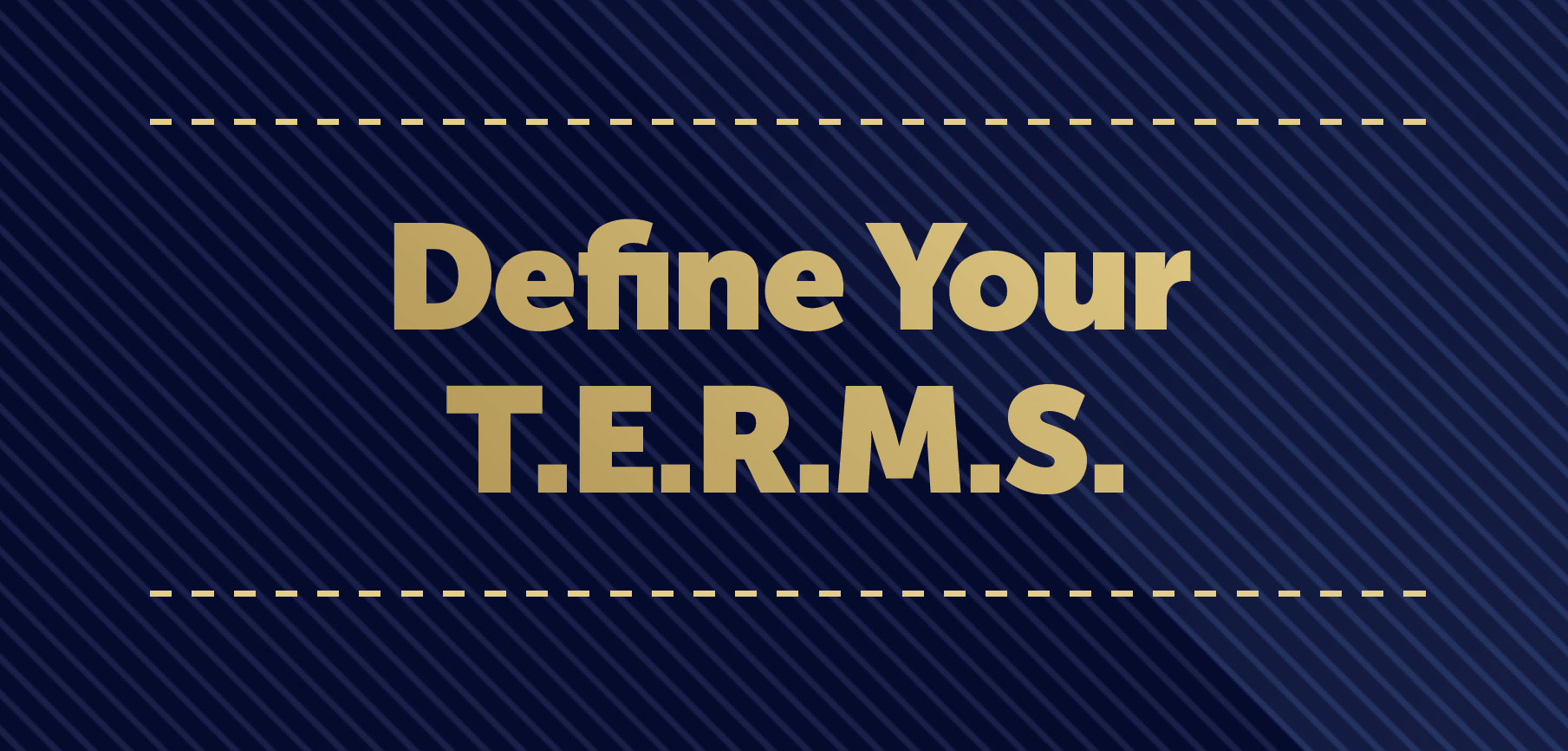Your basket is currently empty!

Understanding your T.E.R.M.S for a balanced life
Understanding Your T.E.R.M.S
Running a business can be both exhilarating and exhausting. The secret to achieving harmony between professional success and personal fulfilment lies in defining your T.E.R.M.S, a personalised framework for living and working on your terms. Our Masterplan is here to help you identify and execute your T.E.R.M.S, ensuring clarity and control over what matters most.
This article delves into the core elements of T.E.R.M.S: Time, Effort, Resources, Money, and Sanity. It empowers you to build a business and lifestyle that truly resonates with your goals.
What Are T.E.R.M.S and Why Do They Matter?
Your T.E.R.M.S are a blueprint for defining how you want to live and operate your business. Each person has unique aspirations, goals, and priorities. Establishing your T.E.R.M.S ensures that your business aligns with your life vision, fostering clarity, purpose, and peace of mind.
By articulating your T.E.R.M.S, you gain:
- A clear focus on daily priorities.
- Defined metrics to track business success.
- Guidance on what to prioritise or eliminate.
The Core Elements of T.E.R.M.S
T.E.R.M.S stands for:
- Time: How you allocate your hours daily and weekly.
- Effort: The energy and passion you bring to your work.
- Resources: The tools, spaces, and people you leverage.
- Money: Your financial goals for the present and the future.
- Sanity: Maintaining mental and emotional well-being.
T is for Time: Designing a Schedule That Works for You
Time is the most precious asset, yet it’s finite. Establishing how much time you’re willing to dedicate to your business is crucial.
Defining Time Commitments
- Evaluate personal responsibilities like family, hobbies, and health.
- Create non-negotiable blocks for personal priorities.
Example: Nigel Botterill’s Time Plan
Nigel Botterill chooses not to work on Fridays from lunchtime. This decision reflects his commitment to work-life balance.
Actionable Steps
- Set Boundaries: Establish working hours that align with your lifestyle.
- Prioritise Tasks: Focus on high-impact activities and delegate to others.
- Eliminate Time Drains: Identify and stop low-value tasks.
By clarifying your time, you’ll maximise productivity and achieve personal fulfilment.
E is for Effort and Energy: Focusing on What Fuels You
Effort without enjoyment leads to burnout. Your business should energize you, not drain you.
Identifying Energy Boosters and Drainers
- Assess which tasks excite you versus those that sap your enthusiasm.
- Create systems to minimise or eliminate unfulfilling activities.
Case Study: Nigel’s Office Dynamics
Nigel prioritizes working in an office surrounded by a team, as it fuels his energy. Conversely, he avoids tasks that diminish his productivity.
Key Strategies
- Outsource Tedious Tasks: Delegate repetitive or unskilled work.
- Design Your Day for Energy: Schedule high-energy tasks during peak performance hours.
- Focus on Enjoyment: Choose projects that align with your passion.
Balancing effort and energy ensures long-term motivation and satisfaction.
R is for Resources: Leveraging What You Have
Resources encompass everything from physical spaces to human capital. The way you utilise these assets shapes your business’s success.
Defining Resource Needs
- What kind of workspace suits you—home office or external location?
- Do you prefer working solo or managing a team?
Examples of Resource Allocation
- Martin operates a lean business with just himself and his wife, prioritising flexibility.
- Nigel, on the other hand, runs a large office, valuing collaboration and structure.
Actionable Insights
- Streamline Tools: Use technology to automate routine processes.
- Customise Your Environment: Set up spaces that inspire creativity and focus.
- Invest in Growth: Hire strategically to fill skill gaps.
By optimising resources, you can scale effectively without sacrificing quality or personal preferences.
M is for Money: Aligning Finances with Your Goals
Money is both a necessity and a motivator. However, financial goals should extend beyond immediate needs to include long-term aspirations.
Two Financial Pillars
- Money Now: Income required for current living expenses.
- Money Future: Savings and investments for sustained security.
Crafting a Financial Blueprint
- Determine how much income your business needs to support your desired lifestyle.
- Set aside funds for future investments and emergencies.
Tips for Financial Clarity
- Budget Wisely: Track and allocate funds to essential categories.
- Plan for Growth: Reinvest profits into the business strategically.
- Minimise Debt: Avoid over-leveraging resources.
Financial discipline ensures your business thrives without compromising personal goals.
S is for Sanity: Safeguarding Your Mental Health
Running a business is a high-stakes endeavour. Without prioritising mental well-being, you risk burnout.
Maintaining Your Sanity
- Set limits on how much stress and pressure you’re willing to endure.
- Regularly evaluate your emotional connection to your business.
Reflection Questions
- On a scale of 1 to 10, how much do you love your business?
- What steps could elevate this number?
Strategies for Mental Resilience
- Create Breaks: Incorporate downtime to recharge.
- Seek Support: Build a network of mentors or peers for guidance.
- Stay Aligned: Regularly revisit your T.E.R.M.S to ensure alignment with personal goals.
By nurturing sanity, you’ll foster a sustainable business mindset.
Conclusion: Living and Working on Your T.E.R.M.S
Defining and living by your T.E.R.M.S creates a seamless integration between your business and personal life. It’s not just about achieving professional milestones but doing so in a way that resonates with your core values.
By clarifying your priorities in Time, Effort, Resources, Money, and Sanity, you’ll gain the confidence and clarity to pursue success on your own terms.
FAQs
1. How do I start defining my T.E.R.M.S?
Begin by listing your top personal and professional priorities. Then allocate time, energy, and resources to each category.
2. What if my T.E.R.M.S change over time?
Your T.E.R.M.S should evolve as your goals and circumstances shift. Revisit and adjust them periodically.
3. How can I balance work and personal life effectively?
Set clear boundaries, prioritize non-negotiables, and delegate tasks that don’t align with your core focus.
4. Is it possible to implement T.E.R.M.S in a large business?
Yes, the principles of T.E.R.M.S are scalable. Communicate your framework with your team to ensure alignment.
5. What tools can help me manage my T.E.R.M.S?
Project management tools like Trello or Asana and scheduling apps like Google Calendar can streamline your workflow.
View Our Most Recent Blogs
-
First Impressions Count – Is Your Website Legally Compliant?
—
by
First Impressions in the Digital Age A missing privacy policy or cookie consent banner might seem minor, but its absence can send a loud message to visitors (and regulators) that…
-
Managing resistant C-Suite executives
—
by
Navigating their feedback Challenges Dealing with Resistant C-Suite Executives: Are You Ready to Navigate Their Feedback Challenges? How a Coach Can Help You C-suite executives often occupy a unique position…
-
Your T.E.R.M.S
—
by
Understanding your T.E.R.M.S for a balanced life Understanding Your T.E.R.M.S Running a business can be both exhilarating and exhausting. The secret to achieving harmony between professional success and personal fulfilment…


